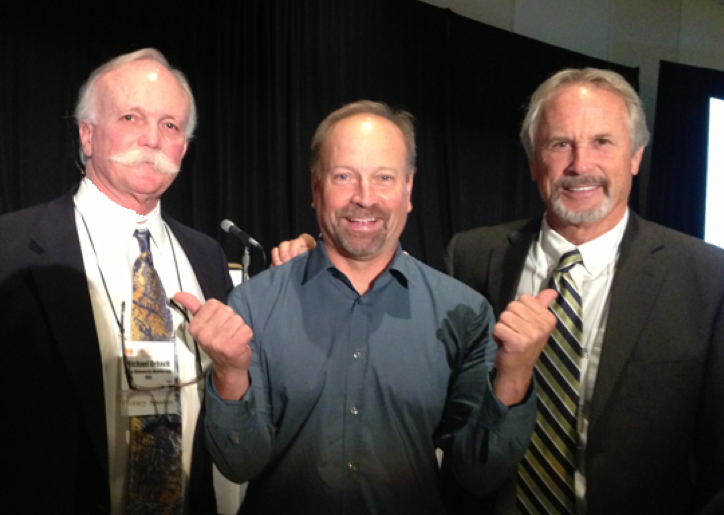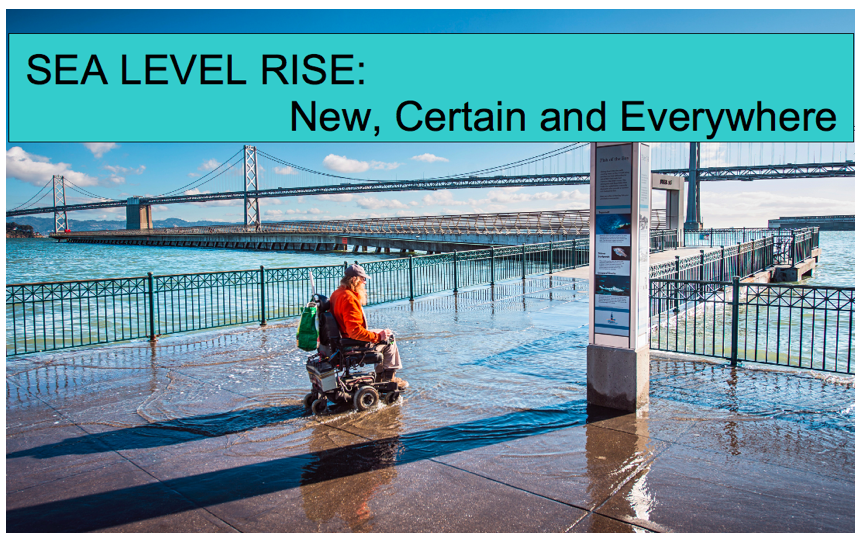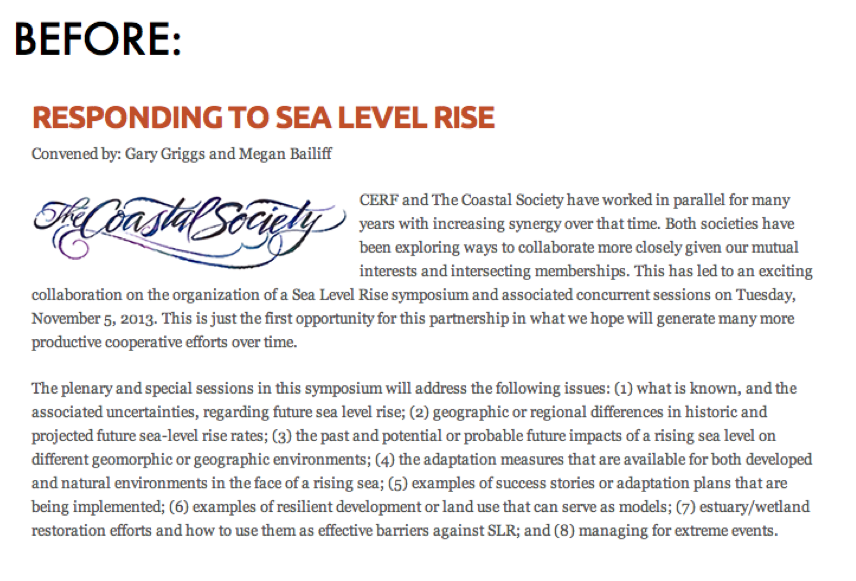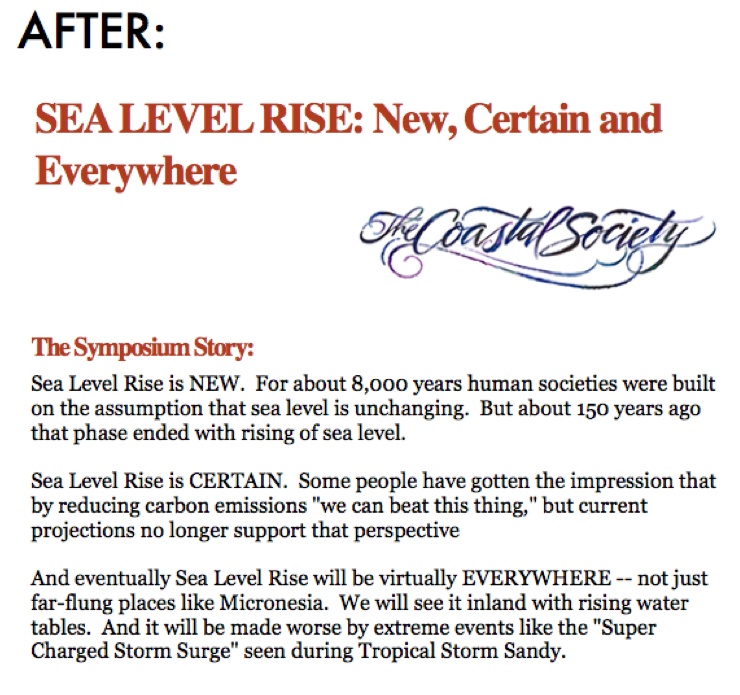#313) CERF: Anatomy of a Successful Plenary Panel on Sea Level Rise
November 6th, 2013
Take two already-gifted speakers, add a guy with a new book on narrative structure, turn up the heat with an important topic like sea level rise, throw in 6 weeks of planning effort and conference calls, then put them in front of 1,000 people and you’ve got an event that works. All of which is a tribute to the brave vision of Megan Baliff, the organizer who came up with a crazy idea this past summer. A crazy idea that worked.
THESE GUYS ARE GOOD. That’s Mike Orbach of Duke University on the left, Gary Griggs of U.C. Santa Cruz on the right. Together they turned in a great performance yesterday in our plenary panel at the Coastal and Estuarine Research Federation meeting in San Diego. Gary presented the SCIENCE, Mike provided the HUMAN PERSPECTIVE on how we will be impacted in the future. (btw, those are shadows on my shirt — though it looks like sweat, which wouldn’t have been a surprise)
I QUIT, NOW LET’S PUT ON A GREAT PANEL
That’s how it all started. My friend Megan Baliff contacted me in June asking me to be part of a “plenary panel” at CERF 2013 saying, “you’ll get to talk about your communications stuff in front of 1,000 people.” I was busy but thought why not and said sure.
But then in mid-September I looked at the website for the meeting and found out what I’d gotten myself into — a panel on “sea level rise” — something I know zippo about. I called up Megan, a little grouchy, asking what the hell she had gotten me into. She said, “No, no, no, this is exactly what we have in mind — we want you to bring “the Randy Olson storytelling thing.”
To make a very complicated story short, she assured me the two other panelists were wildly enthusiastic about the idea of me overturning their standard presentations and forcing them to do something they had never done before. She was wrong, they were definitely not psyched (can’t blame ’em), I sensed the whole thing would be too much work and too painful, so by early October I simply quit.
But while I was on the phone with Megan, handing in my resignation and she was gracefully accepting it, honest to goodness, an email from one of the two guys popped up and it said they had discussed my crazy ideas, agreed they had both given enough successful presentations in their careers, they could afford one horribly embarrassing debacle, so they were ready to give it a shot. Amazing timing. The whole thing came that close to never happening.
COMMUNICATING THE FUTURE. Sea level rise is “NEW” (after 8000 years of stability, the past 150 years now shows accelerating rising levels), “CERTAIN” (it’s gonna happen — nothing we can do now is going to stop it), and “EVERYWHERE” (not just the middle of the Pacific — it’s going to hit places considerably inland, even impacting groundwater dynamics in some inland areas).
YOU GET BACK WHAT YOU INVEST
So here’s the sad and simple truth of communication. EVERYONE dreams of doing it well, but almost nobody wants to put in the time and resources needed. That’s pretty much the truth of it all. Institutions run communications workshops thinking, “we’ll give this communications stuff a day then everyone will be all set for eternity.” I swear, they really do. But it doesn’t work that way. It takes time and long term commitment. This is why we’re going with the term, “Narrative Training” to refer to what we are now advocating with our Connection Storymaking workshops.
If you value effective communication, you have to INVEST in it. We certainly did for this event. We had an initial, obligatory conference call. I had to push the guys for a second one. But by the third week they began to realize we were concocting something challenging. That’s when the tide shifted. THEY began pushing ME to have more communication. I stopped having to push them. They started turning up the heat — saying look, if you’re going to throw us out in front of 1,000 people, we’d better get this thing smoothed out.
But from the start it was destined for success because the two guys had so much material to draw from, plus they have such good communications instincts to begin with. The only thing they could use some help with, as is the case with absolutely EVERYONE in the ENTIRE WORLD, was narrative structure.
This is why Hollywood movies are made by TEAMS of people. Not just one scientist sitting alone in his office organizing his slides. You HAVE to collaborate if you want to make the good stuff.
IF YOU CAN’T GIVE ME THE ONE WORD, I’LL SETTLE FOR THE THREE WORDS
It started with me asking the guys my standard question of, “What is the ONE WORD that encapsulates this ENTIRE subject of sea level rise” I pushed and pushed them. But they pushed back. They couldn’t find any “one word.” However, they did finally settle on three words. I said, “Close enough,” and those words turned into the title for the session — new, certain and everywhere. Which ended up sounding like the title of a book — like “Guns, Germs and Steel,” or “Hot, Flat and Crowded.”
From there the rest was a breeze. Once we had our three topics, it was just a matter of shaping their material into a solid template of, “1 – Perception, 2 – Reality, 3 – Communication, 4 – Humor.” For each of the three “stories” I helped them structure their material around this pattern, then we got on stage and they delivered the final ingredient — the performance. Gary came through with a lot of humor, Mike brought to bear his commanding oratorical presence, finishing the session with his list of four solemn recommendations on how we must start getting ready for sea level rise.
It really was a tremendous event. I was just the host of the party. The two guys were the life of the party. Overall, it was a whole bunch of fun. And there was one more element which was our “crowd contributions.” Using the ABT template we had contributions from people around the country — from Alaska to California to Florida — including an amazing spontaneous performance from Nic Kinsman (a former student of Gary) talking about sea level rise problems in Alaskan coastal villages.
And on the humor front, I interviewed Andrew David Thaler last week about his hilarious, “Drown Your Town” feature. He sent me some great samples to share with the crowd (thanks Jackie Yeary for initially telling me about his website) including the fact that of the first 1,000 people asking him to “drown towns” a third wanted to see Washington D.C. underwater because of the shutdown, plus they asked him to make the water brown.
WE DON’T NEED MORE SCIENCE, WE NEED GREAT COMMUNICATION LIKE THIS
When we finished, the first person for the Q&A was a young woman who stepped up to the microphone, literally turned her back on us, then spoke to the entire crowd of a thousand. She said basically, “I know some of you may find this offensive, but we don’t need more science — what we need is effective communication like this.” It was such a wonderful and powerful endorsement that Gary asked me later if I had hired her — I had not (and by the way, the last time the first speaker in a Q&A turned their back on me it was the guy at Syracuse who told the 250 people in the audience, “This guy’s book is great, but this talk of his sucked” — but that’s a different story).
It was a very gratifying experience. Mike, Gary and I went to dinner the evening before and kind of braced ourselves for the big experiment. No one felt certain the thing would work. But you know what, there’s a kind of excitement that comes from taking chances like that. Both of them absolved me of potential guilt — saying that even if it ended up as a mess, they were excited to just be trying something different.
And in the end, all I can emphasize again is how much effort it took. There was very enthusiastic applause at the end and a whole crowd of people came up to the stage to rave about how much they enjoyed it. One of the organizers said he had taken part in probably two hundred panels over the years, but this one was the very best. Which was great. But let me just make it abundantly clear. I don’t think any of the three of us have put that much effort into a public presentation, ever before. I know I haven’t (and btw, back when I was a scientist I was notorious for, “organizing my slides on the plane”).
So just ask yourself — how important is communication? That’s the bottom line.
PLENARY PANEL: THE HOME MAKEOVER EDITION
Here’s the “Before and After” of the event description on the CERF website over the past month — the initial description of the event before I was recruited, then the “makeover” the three of us gave it — adding “narrative structure” to the content. This is the exact goal of our new book, Connection: Hollywood Storytelling meets Critical Thinking — which by the way, Dorie, Brian and I discuss in detail in this great podcast with Skeptic Magazine that they posted yesterday.



